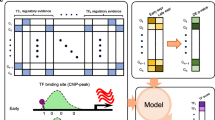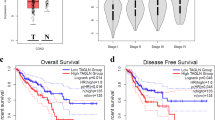Abstract
The mechanism by which tissue microecology influences invasion and metastasis is largely unknown. Recent studies have indicated differences in the molecular architecture of the metastatic lesion compared to the primary tumor, however, systemic analysis of the alterations within the activated protein signaling network has not been described. Using laser capture microdissection, protein microarray technology, and a unique specimen collection of 34 matched primary colorectal cancers (CRC) and synchronous hepatic metastasis, the quantitative measurement of the total and activated/phosphorylated levels of 86 key signaling proteins was performed. Activation of the EGFR–PDGFR-cKIT network, in addition to PI3K/AKT pathway, was found uniquely activated in the hepatic metastatic lesions compared to the matched primary tumors. If validated in larger study sets, these findings may have potential clinical relevance since many of these activated signaling proteins are current targets for molecularly targeted therapeutics. Thus, these findings could lead to liver metastasis specific molecular therapies for CRC.



Similar content being viewed by others
Abbreviations
- CRC:
-
Colorectal cancer
- LCM:
-
Laser capture microdissection
- RPMA:
-
Reverse phase protein microarray
- EGFR:
-
Epithelial growth factor
- RTK:
-
Receptor tyrosine kinase
References
Siegel R, Naishadham D (2012) Cancer statistics, 2012. CA Cancer J Clin 62(1):10–29
Field K, Lipton L (2007) Metastatic colorectal cancer—past, progress and future. World J Gastroenterol 13(28):3806–3815
Kopetz S, Chang GJ, Overman MJ et al (2009) Improved survival in metastatic colorectal cancer is associated with adoption of hepatic resection and improved chemotherapy. J Clin Oncol 27(22):3677–3683
Luzzi KJ, MacDonald IC, Schmidt EE et al (1998) Multistep nature of metastatic inefficiency: dormancy of solitary cells after successful extravasation and limited survival of early micrometastases. Am J Pathol 153(3):865–873
Paget S (1989) The distribution of secondary growths in cancer of the breast. Cancer Metastasis Rev 8(2):98–101
Joyce T, Pintzas A (2007) Microarray analysis to reveal genes involved in colon carcinogenesis. Expert Opin Pharmacother 8(7):895–900
Li M, Lin YM, Hasegawa S et al (2004) Genes associated with liver metastasis of colon cancer identified by genome-wide cDNA microarray. Int J Oncol 24(2):305–312
Bertucci F, Salas S, Eysteries S et al (2004) Gene expression profiling of colon cancer by DNA microarrays and correlation with histoclinical parameters. Oncogene 23(7):1377–1391
Houlston RS (2001) What we could do now: molecular pathology of colorectal cancer. Mol Pathol 54(4):206–214
Driouch K, Landemaine T, Sin S et al (2007) Gene arrays for diagnosis, prognosis and treatment of breast cancer metastasis. Clin Exp Metastasis 24(8):575–585
Mendez E, Fan W, Choi P et al (2007) Tumor-specific genetic expression profile of metastatic oral squamous cell carcinoma. Head Neck 29(9):803–814
Petricoin EF III, Bichsel VE, Calvert VS et al (2005) Mapping molecular networks using proteomics: a vision for patient-tailored combination therapy. J Clin Oncol 23(15):3614–3621
Gulmann C, Sheehan KM, Kay EW et al (2006) Array-based proteomics: mapping of protein circuitries for diagnostics, prognostics, and therapy guidance in cancer. J Pathol 208(5):595–606
Wulfkuhle JD, Edmiston KH, Liotta LA et al (2006) Technology insight: pharmacoproteomics for cancer—promises of patient-tailored medicine using protein microarrays. Nat Clin Pract Oncol 3(5):256–268
Anderson L, Seilhamer J (1997) A comparison of selected mRNA and protein abundances in human liver. Electrophoresis 18(3–4):533–537
Gygi SP, Rochon Y, Franza BR et al (1999) Correlation between protein and mRNA abundance in yeast. Mol Cell Biol 19(3):1720–1730
Hynes NE, Lane HA (2005) ERBB receptors and cancer: the complexity of targeted inhibitors. Nat Rev Cancer 5(5):341–354
Espina V, Wulfkuhle JD, Calvert VS et al (2006) Laser-capture microdissection. Nat Protoc 1(2):586–603
Espina V, Heiby M, Pierobon M et al (2007) Laser capture microdissection technology. Expert Rev Mol Diagn 7(5):647–657
VanMeter A, Signore M, Pierobon M et al (2007) Reverse-phase protein microarrays: application to biomarker discovery and translational medicine. Expert Rev Mol Diagn 7(5):625–633
Speer R, Wulfkuhle J, Espina V et al (2007) Development of reverse phase protein microarrays for clinical applications and patient-tailored therapy. Cancer Genomics Proteomics 4(3):157–164
Speer R, Wulfkuhle JD, Liotta LA et al (2005) Reverse-phase protein microarrays for tissue-based analysis. Curr Opin Mol Ther 7(3):240–245
Espina V, Mehta AI, Winters ME et al (2003) Protein microarrays: molecular profiling technologies for clinical specimens. Proteomics 3(11):2091–2100
Wulfkuhle JD, Speer R, Pierobon M et al (2008) Multiplexed cell signaling analysis of human breast cancer applications for personalized therapy. J Proteome Res 7(4):1508–1517
Winters M, Dabir B, Yu M et al (2007) Constitution and quantity of lysis buffer alters outcome of reverse phase protein microarrays. Proteomics 7(22):4066–4068
Pierobon M, Calvert V, Belluco C et al (2009) Multiplexed cell signaling analysis of metastatic and nonmetastatic colorectal cancer reveals COX2-EGFR signaling activation as a potential prognostic pathway biomarker. Clin Colorectal Cancer 8(2):110–117
Markowitz SD, Bertagnolli MM (2009) Molecular origins of cancer: molecular basis of colorectal cancer. N Engl J Med 361(25):2449–2460
Jones S, Chen WD, Parmigiani G et al (2008) Comparative lesion sequencing provides insights into tumor evolution. Proc Natl Acad Sci USA 105(11):4283–4288
Scartozzi M, Bearzi I, Berardi R et al (2004) Epidermal growth factor receptor (EGFR) status in primary colorectal tumors does not correlate with EGFR expression in related metastatic sites: implications for treatment with EGFR-targeted monoclonal antibodies. J Clin Oncol 22(23):4772–4778
Italiano A, Hostein I, Soubeyran I et al (2010) KRAS and BRAF mutational status in primary colorectal tumors and related metastatic sites: biological and clinical implications. Ann Surg Oncol 17(5):1429–1434
Knijn N, Mekenkamp LJ, Klomp M et al (2011) KRAS mutation analysis: a comparison between primary tumors and matched liver metastases in 305 colorectal cancer patients. Br J Cancer 104(6):1020–1026
Vermaat JS, Nijman IJ, Koudijs MJ et al (2012) Primary colorectal cancers and their subsequent hepatic metastases are genetically different: implications for selection of patients for targeted treatment. Clin Cancer Res 18(3):688–699
Ericson K, Gan C, Cheong I et al (2010) Genetic inactivation of AKT1, AKT2, and PDPK1 in human colorectal cancer cells clarifies their roles in tumor growth regulation. Proc Natl Acad Sci USA 107(6):2598–2603
Rychahou PG, Kang J, Gulhati P et al (2008) Akt2 overexpression plays a critical role in the establishment of colorectal cancer metastasis. Proc Natl Acad Sci USA 105(51):20315–20320
Loupakis F, Pollina L, Stasi I et al (2009) PTEN expression and KRAS mutations on primary tumors and metastases in the prediction of benefit from cetuximab plus irinotecan for patients with metastatic colorectal cancer. J Clin Oncol 27(16):2622–2629
Espina V, Edmiston KH, Heiby M et al (2008) A portrait of tissue phosphoprotein stability in the clinical tissue procurement process. Mol Cell Proteomics 7(10):1998–2018
Acknowledgments
This work was supported by the Italian Istituto Superiore di Sanita` in the framework of the Italy/USA cooperation agreement between the US Department of Health and Human Services, George Mason University, and the Italian Ministry of Public Health, as well as the generous support of the College of Science, George Mason University.
Conflict of interest
The authors are inventors on US Government and University assigned patents and patent applications that cover aspects of the technologies discussed. As inventors, they are entitled to receive royalties as provided by US Law and George Mason University policy. VC, MP, LL, and EP are consultants to and shareholders of Theranostics Health, LLC.
Author information
Authors and Affiliations
Corresponding author
Electronic supplementary material
Below is the link to the electronic supplementary material.
Rights and permissions
About this article
Cite this article
Silvestri, A., Calvert, V., Belluco, C. et al. Protein pathway activation mapping of colorectal metastatic progression reveals metastasis-specific network alterations. Clin Exp Metastasis 30, 309–316 (2013). https://doi.org/10.1007/s10585-012-9538-5
Received:
Accepted:
Published:
Issue Date:
DOI: https://doi.org/10.1007/s10585-012-9538-5




